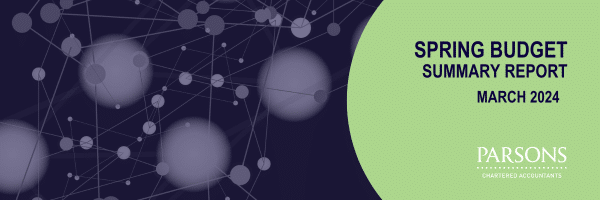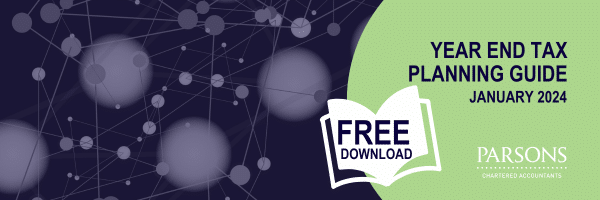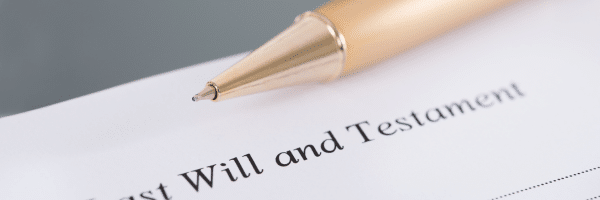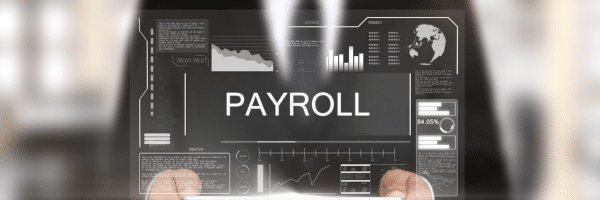MARCH 2024
Chancellor Jeremy Hunt delivered his ‘budget for long term growth’ on Wednesday 6 March 2024. His speech promised ‘more investment, more jobs, better public services and lower taxes’.
READ OUR SUMMARY REPORT . SPRING BUDGET 2024
FEBRUARY 2024
The run up to the end of the tax year on 5 April 2024 is a good time to make sure that your family and business finances are arranged in the best way possible.
The freeze of many tax rates and thresholds continues to increase the government’s tax take, but there are still many useful ways to arrange your affairs tax efficiently. Our Year End Tax Planning Guide provides an overview of some of these, alongside tips from our experts.
download the guide now
If you have some spare cash, an obvious tax planning point would be to maximise your ISA allowances for the 2023/24 tax year (currently £20,000 each). You might also want to consider increasing your pension savings before 5 April 2024.
Those aged between 18 and 40 can set up a Lifetime ISA (Individual Savings Account) to buy their first home or save for later life. You can put in up to £4,000 each year until you’re 50. The government will add a 25% bonus to your savings, up to a maximum of £1,000 per year. Note that the Lifetime ISA limit of £4,000 counts towards your £20,000 annual ISA limit.
You can withdraw money from your ISA if you’re:
- buying your first home,
- aged 60 or over, or
- terminally ill, with less than 12 months to live.
However, you’ll pay a withdrawal charge of 25% if you withdraw cash or assets for any other reason (an unauthorised withdrawal). This recovers the government bonus you received on your original savings.
FIND MORE DETAIL AND TIPS IN OUR TAX PLANNING GUIDE. DOWNLOAD THE GUIDE
Under the current rules, the government adds to your pension contributions at the 20% basic rate. For instance, if you save £4,000 in a personal pension, the government tops this up to £5,000. If you are a higher rate taxpayer there is a further £1,000 tax relief when your tax liability is calculated, reducing the net cost to £3,000.
Additional pension contributions can be even more effective if your income is between £100,000 and £125,140 as the gross pension contribution reduces net income for the purposes of the reduction in the personal allowance. Note that for every £2 of income in excess of £100,000, the £12,570 personal allowance is reduced by £1, with reduction to nil where net income is £125,140 or more. This is effectively a 60% tax saving.
Making pension contributions remains one of the most tax efficient ways to invest for your future. Whether you are a director-shareholder, self-employed business person or partner, we would be happy to discuss this area with you further, and make a plan for your personal circumstances.
YOU CAN FIND MORE DETAIL ABOUT YEAR END PENSION PLANNING IN OUR TAX PLANNING GUIDE, WHICH CONTAINS SOME PARTICULARLY HELPFUL INFORMATION FOR HIGHER EARNERS. DOWNLOAD THE GUIDE
You might wish to consider bringing forward capital gains to before 6 April 2024 where you haven’t used your £6,000 CGT annual exemption. This exempt amount reduces to just £3,000 for gains made in 2024/25.
YOU CAN FIND MORE DETAIL ABOUT CGT RULES, CHANGES AND PLANNING TIPS IN OUR TAX PLANNING GUIDE. DOWNLOAD THE GUIDE
2022/23 income tax, CGT, class 2 and 4 NIC liabilities should have been paid by 31 January 2024 unless you have agreed a payment plan with HMRC. Note that if the balance is still unpaid at the end of February 2024, a 5% surcharge penalty is added in addition to the normal interest charge unless a payment plan has been agreed.
CONTACT OUR TAX TEAM TODAY IF YOU NEED HELP TO MAKE AN OUTSTANDING PAYMENT
Unless the business year end is 31 March or 5 April, the end of the tax year is not a significant date as far as capital allowances are concerned. In order for new equipment to attract capital allowances, the expenditure must be incurred on or before the end of the accounting period. Limited companies buying new (not second hand) equipment are entitled to fully expense the cost of most acquisitions against business profits. There is no financial limit on expenditure qualifying for this “full expensing” relief.
Unincorporated businesses are entitled to 100% write off for the first £1 million spent on new and used equipment in a 12 month period. This “annual investment allowance” (AIA) is also available to limited companies buying second hand equipment. The AIA does not apply to motor cars but there is a special 100% tax relief if you buy a new zero-emissions motor car.
Where equipment is bought under a hire purchase contract, the capital allowances outlined above are available on the full cost of the asset provided it has been brought into use by the end of the accounting period. This is despite the fact that the payments may be spread over a number of months.
On top of the major changes to research and development (R&D) tax relief that took effect from 1 April 2023, there are yet more changes that take effect from 1 April 2024.
The main change from 1 April 2024 is that most companies carrying out qualifying R&D will be entitled to a 20% expenditure credit. The 20% is calculated on the amount of qualifying expenditure. Qualifying expenditure is extended to include subsidised expenditure from 1 April 2024, although R&D carried out overseas will no longer qualify unless the work cannot be undertaken in the UK.
“R&D intensive” companies that make trading losses will continue to be entitled to a tax refund instead of the expenditure credit. The definition of “R&D intensive” is reduced from 40% to 30% from 1 April 2024, which means a company that spends at least 30% of total expenditure on qualifying R&D.
R&D TAX RELIEF CONTINUES TO BE A COMPLEX AREA. WE CAN WORK WITH YOU TO HELP YOU PREPARE A VALID CLAIM
The table below sets out the HMRC advisory fuel rates from 1 March 2024. These are the suggested reimbursement rates for employees’ private mileage using their company car.
Where the employer does not pay for any fuel for the company car, these are the amounts that can be reimbursed in respect of business journeys without the amount being taxable on the employee.
Where there has been a change the previous rate is shown in brackets.
You can also continue to use the previous rates for up to 1 month from the date the new rates apply.
Note that for hybrid cars you must use the petrol or diesel rate.
For fully electric vehicles the rate is 9p (10p) per mile.
| ENGINE SIZE | PETROL | DIESEL | LPG |
| 1400cc or less | 14p (14p) | 10p (10p) | |
| 1600cc or less | 13p (13p) | ||
| 1401cc to 2000cc | 16p (16p) | 12p (12p) | |
| 1601cc to 2000cc | 15p (15p) | ||
| Over 2000cc | 26p (26p) | 20p (20p) | 18p (18p) |
JANUARY 2024
At this time of year, we think about New Year’s resolutions. It is also a good time to start planning your tax affairs before the end of the tax year on 5th April.
An obvious tax planning point would be to maximise your ISA allowances for the 2023/24 tax year (currently £20,000 each). You might also want to consider increasing your pension savings before 5 April 2024, as the unused annual pension allowance from 2020/21 lapses after three years.
Many of us get together with the family at Christmas and that prompts us to think about making or updating our Will.
At the top of the New Year to do list for many individuals is to make or update their Will. Many think this is something to leave until later in life, but it is important to get things in place once property is acquired or when children come along.
In the absence of a will there are statutory rules which dictate how your assets are distributed on death. Those statutory intestacy rules may not be tax efficient, and you might to want to make specific provision in your Will for your unmarried partner or for the guardianship of your children.
People often think that if they die without making a Will, their spouse (or civil partner) will automatically inherit everything, but this is not necessarily the case. According to the laws of intestacy in England, for deaths occurring on or after 26 July 2023, the surviving spouse would inherit a statutory legacy of £322,000, all of the personal effects, and half of the remaining estate. The deceased’s surviving children (or their descendants) would split the remaining half of the estate equally. If those descendants are under the age of 18, their inheritance is kept back for them until they turn 18. Note that intestacy rules are different in Scotland, Wales and Northern Ireland.
When considering the wording of your Will, you should note that the inheritance tax (IHT) nil rate band continues to be frozen at £325,000, subject to any announcements in the Spring Budget. There is currently an additional nil rate band of up to £175,000 for passing on the family home to direct descendants on death. We can work with your solicitor to make sure your Will is tax efficient.
Where some of the nil bands are unused on the death of the first spouse, the balance is available on the death of the surviving spouse, potentially allowing a married couple (or civil partners) to pass on assets of up to £1 million at today’s rates without paying IHT.
The residence nil band is even available when you downsize to a cheaper property. For example, if a married couple currently live in a large house worth £500,000 and downsize to a flat worth £300,000, they could give away some of the proceeds during their lifetime and yet still benefit from inheritance tax relief based on the higher valued property. They could even sell the house and move into a rental property or a care home and still benefit from this nil band.
If you leave at least 10% of your estate to charity, the rate of Inheritance tax on the amount chargeable Is reduced from 40% over the nil rate bands to just 36%. This would reduce the amount passing to other beneficiaries and needs to be carefully considered. Our experts are on hand to review your circumstances and can work with you to create a plan.
Many were expecting an announcement from the Chancellor in the Autumn Statement about cuts to, or the possible abolition of, inheritance tax (IHT). Maybe he is saving that for his Spring Budget, but in the meantime, it may be worth utilising the £3,000 gifts annual exemption for 2023/24 and, if available, the unused amount from 2022/23. Note that £3,000 is the overall exemption for the tax year, not the amount for each one. More generous amounts can be given away by taking advantage of the exemption for regular gifts out of income.
REGULAR GIFTS OUT OF YOUR INCOME CAN SAVE IHT
One tax planning opportunity that many thought the chancellor might restrict was the exemption from inheritance tax for regular gifts out of an individual’s surplus income. Inheritance tax is designed to tax transfers of capital, so if the donor can demonstrate that the gifts are made out of surplus income then the transfers are not taken into consideration for IHT. The exemption applies where there is a regularity to the payments, such as a standing order to pay school fees or pension contributions on behalf of children or grandchildren. HMRC will also require proof that the payments are paid out of post-tax income and do not limit the donor’s normal lifestyle. Detailed records are required and our team will be happy to help you to compile them.
Normally an individual’s payments into a pension scheme are limited to their relevant earnings in a given tax year. This restriction does not apply where the contributions are less than £3,600 gross, allowing parents and grandparents to make payments on behalf of children and grandchildren with limited income.
Payments of £2,880 a year would attract a 25% uplift from the government which could grow to a substantial amount by the time the child reaches retirement age (currently age 55, but increasing to 57 in 2028). The parent or grandparent may be able to justify that the payments qualify for the regular gifts out of income exemption from inheritance tax mentioned above if a standing order was set up for no more than £240 a month.
If you have maximised your own pension contributions and have surplus income, you might want to pay into your spouse’s or child’s pension by way of a tax-efficient gift that can support their long-term financial security. Within the right circumstances, timely contributions may reduce future inheritance tax bills or help a pension owner affected by the ‘high income benefit charge’ to qualify for child benefit payments. There is a lot to consider around pensions and we would always recommend you take advice.
The chancellor’s announcement of a 2% cut in national insurance contributions (NICs) for employees applies to payments on or after 6 January 2024. Note that for employees other than directors, NIC is not calculated on a cumulative basis so, where over-deductions are made, the error is not automatically corrected in later months.
The table below sets out the HMRC advisory fuel rates from 1 December 2023. These are the suggested reimbursement rates for employees’ private mileage using their company car.
Where the employer does not pay for any fuel for the company car, these are the amounts that can be reimbursed in respect of business journeys without the amount being taxable on the employee.
Where there has been a change the previous rate is shown in brackets.
You can also continue to use the previous rates for up to 1 month from the date the new rates apply.
Note that for hybrid cars you must use the petrol or diesel rate.
For fully electric vehicles the rate is 9p (10p) per mile.
| ENGINE SIZE | PETROL | DIESEL | LPG |
| 1400cc or less | 14p (13p) | 10p | |
| 1600cc or less | 13p (12p) | ||
| 1401cc to 2000cc | 16p | 12p | |
| 1601cc to 2000cc | 15p (14p) | ||
| Over 2000cc | 26p (25p) | 20p (19p) | 18p (19p) |
Innovate UK BridgeAI is funding an online training course to help businesses and organisations explore digital, data-driven and AI technologies.
The training course is designed with decision-makers in mind, in businesses and organisations of any size in agriculture, creative industries, construction, and transportation. It will help you decide what your organisation needs and put together an action plan for making your business digital ready.
This introductory-level series will explain why and how to implement AI to best benefit your business.
There are five sessions that can be taken individually or as a series. The sessions include:
- Making data work for you
- AI applications in industry
- Modelling: A fundamental capability
- Why digital twins?
- Scalable platforms supporting digital transformation
The 5 sessions are first being run in a weekly series starting Wednesday 24 January 2024. A second series begins on Tuesday 2 April 2024, with a third series commencing Wednesday 18 September 2024. The training programme is free – register here.
Second call for Digital Innovation Fund
A second round of funding has been launched by Smart Manufacturing Data Hub (SMDH) for their Digital Innovation Fund. This funding is available to all small and medium sized businesses across the UK.
SMDH state that this second call “focusses on developing rapid demonstrator solutions that enable SMEs to advance their smart manufacturing journeys, de-risking major investment yet enabling growth.”
Small and medium sized businesses in the manufacturing sector that can demonstrate demand for a new data driven solution can apply for grant funding of up to £50,000.
The funding can then be used to help develop the concept into a market ready solution. A requirement of the grant is that this be done within 6 months of the grant award.
Further information about the grant and how to apply can be found at https://smdh.uk/demonstrator
Storm Henk caused widespread flooding and damage across England during the first few days of 2024, affecting households and businesses alike. Following this, the government has announced that financial support is available to eligible areas in England that have experienced exceptional localised flooding.
In these eligible areas, the following help will be made available to significantly affected and eligible businesses:
- 100% business rates relief for at least 3 months;
- Up to £2,500 from the Business Recovery Grant that can be applied for by small-to-medium sized businesses to help quickly return to business as usual;
- £5,000 from the Property Flood Resilience Repair Grant Scheme to help business property owners make their business more resilient to future flooding; and
- £25,000 through the Farming Recovery Land towards repair and reinstatement costs for farmers suffering uninsurable damage to their land.
This help is available through a scheme called the Flood Recovery Framework. This framework is used to help support councils and communities in exceptional circumstances after severe flooding.
The support can be accessed through councils in the eligible areas. The councils will announce additional details on who is eligible and how to apply.
LOOKING FOR AN OLDER EDITION OF BULLETIN?
CHECK OUT THE DOWNLOADS ARCHIVE ON THE RIGHT OF THIS PAGE.
WELCOME
We know that keeping up with the pace of change surrounding tax policy, news and important accounting deadline dates can be a challenge. Visit Bulletin to ensure you don’t miss a thing, and get in-touch with our team if we can help you with any queries on the news snippets here.
Mailing List Sign-up
Join our mailing list to receive a monthly email notification when we publish fresh news.
After you click the sign-up button you will receive an email to confirm your request and complete the process. Please add our sender address (news@parsons.co.uk) to your contacts/safe senders list to help ensure that Bulletin doesn’t land in your spam/junk folder.
IMPORTANT DATES
| DATE | WHAT’S DUE |
| 19/03 | PAYE & NIC deductions, and CIS return and tax, for month to 05/03/24 (due 22/03 if you pay electronically) |
| 01/04 | Corporation tax payment for the year to 30/6/23 (unless quarterly instalments apply) |
| 05/04 | End of the 2023/24 tax year – many tax planning actions need to have been taken by this date |
| 06/04 | Start of the 2024/25 tax year |
| 19/04 | Employer PAYE & NIC deductions, and CIS return and tax, for the month to 5/4/24 (due 22/4 if you pay electronically) |
| 30/04 | Annual Tax on Enveloped Dwellings (ATED) returns and payment for the chargeable period starting on 1 April 2024 |
DOWNLOADS (PDF)
This material provides only an overview of the regulations in force at the date of publication, and no action should be taken without consulting the detailed legislation or seeking professional advice. No responsibility for loss occasioned by any person acting or refraining from action as a result of the material can be accepted by the authors or the firm.























